Spatial–Temporal Characteristics and Driving Mechanisms of Rural Industrial Integration in China
Abstract
1. Introduction
2. Literature Review and Theoretical Framework
2.1. Literature Review
2.2. Theoretical Framework
3. Materials and Methods
3.1. Evaluation System of Rural Industrial Integration
3.2. Assigning Weights to the Indicators
3.3. Kernel Density Function Approach
3.4. Hotspot Analysis
3.5. Data Source
4. Results and Analysis
4.1. Temporal Characteristics of Rural Industrial Integration
4.2. Spatial Pattern of Rural Industrial Integration
- 1)
- Dimension of agricultural industrial chain extension (Figure 4): During the study period, the scores of Liaoning, Zhejiang and Gansu showed a downward trend, while the scores of the other provinces showed an upward trend to varying degrees. Shanghai and Shandong were always at a high level, which was mainly distributed in the eastern region. In 2020, the scores of the agricultural industrial chain extension in these two provinces were 0.1922 and 0.1299, respectively, which were greater than 0.1000, indicating that the agricultural industrial chain extension capacity had achieved remarkable results. Shanghai and Shandong were early implementers of agricultural industrialization, and the integration model of production, supply and marketing driven by leading enterprises continues to this day, leading other provinces in China. Shanxi, Neimenggu, Chongqing, Qinghai and Xinjiang were at the low level.
- 2)
- Dimension of agricultural multifunctionality (Figure 5): During the study period, the scores of Hainan showed a downward trend, while the scores of the other provinces showed an upward trend to varying degrees. In 2008, Beijing, Tianjin, Chongqing and 12 other provinces were categorized as belonging to high-level or higher-level regions, which were mainly distributed in the southeast and southwest. In 2020, the number of provinces and their spatial distribution showed great changes with respect to 2008. The number of provinces considered to belong to high-level and higher-level areas decreased to seven. High-value clusters gradually formed in the Yangtze River Delta, while the high-value areas in the southwest continued to shrink. It is worth noting that Tianjin steadily improved its capacity for agricultural multifunctionality, leaping from a high level in 2008 to a higher level in 2020. The agricultural business model newly implemented in Fujian, Henan, Hunan and Guangdong has not yet achieved economic transformation, leading to the low level of agricultural multifunctionality.
- 3)
- Dimension of the integrated development of agricultural services (Figure 6): During the study period, each province made steady progress, and their scores increased to varying degrees. The provinces belonging to the higher level changed between the initial stage (Jiangsu, Zhejiang, Shandong, Guangdong and Sichuan) and the final stage (Jiangsu, Zhejiang and Shandong). Jiangsu, Zhejiang and Shandong belong to the Yangtze River coastal economic zone where the tertiary industry is highly developed, and it lays a good foundation for the integrated development of agricultural services. Tibet has always belonged to the lower level. As provinces relying on traditional agriculture and animal husbandry, their agricultural loan investment, agricultural technology investment and rural fixed asset investment are relatively low, leading to the low integrated development of agricultural services.
- 4)
- Dimension of the economic effect of rural industrial integration (Figure 7): The economic effect of rural industrial integration in all provinces showed a steady and positive trend. The economic effect of rural industrial integration in Heilongjiang, Zhejiang and Fujian were at a higher level, with scores of 0.0900, 0.1083 and 0.0947, respectively, in 2020. Among them, the per capita net operating income of rural residents in Heilongjiang ranked the highest in China. The urban–rural income ratio and the urban–rural consumption ratio were 1.9245 and 1.6502, respectively. The urban–rural gap was small. The agricultural labor productivities of Zhejiang and Fujian were CNY 10.6798 million and CNY 8.7672 million, respectively, which were the highest values in China. Guizhou, Shaanxi, Gansu, Yunnan and Tibet belonged to the lower level. The urban–rural income gap was nearly triple, and the agricultural labor productivity was low, leading to these five provinces belonging to the lower level.
4.3. Dynamic Evolutionary Characteristics of Rural Industrial Integration
4.4. Spatial Differentiation Characteristics of Rural Industrial Integration
5. Analysis of the Driving Factors
5.1. Selection of Variables
5.2. Total Regression Analysis
5.3. Regional Regression Analysis
6. Discussion
7. Conclusions and Suggestions
Author Contributions
Funding
Institutional Review Board Statement
Informed Consent Statement
Data Availability Statement
Acknowledgments
Conflicts of Interest
Appendix A
| Region | 2008 | 2010 | 2012 | 2014 | 2016 | 2018 | 2020 |
|---|---|---|---|---|---|---|---|
| Beijing | 0.2473 | 0.3356 | 0.3814 | 0.4298 | 0.4098 | 0.4168 | 0.5007 |
| Tianjin | 0.1646 | 0.2026 | 0.2562 | 0.3435 | 0.4495 | 0.4446 | 0.4587 |
| Hebei | 0.2011 | 0.2147 | 0.2465 | 0.2937 | 0.3172 | 0.3546 | 0.3891 |
| Shanxi | 0.1202 | 0.1440 | 0.1691 | 0.1850 | 0.2585 | 0.2200 | 0.2266 |
| Inner Mongolia | 0.1283 | 0.1284 | 0.1516 | 0.1861 | 0.2052 | 0.2145 | 0.2226 |
| Liaoning | 0.1932 | 0.2212 | 0.2758 | 0.3448 | 0.3339 | 0.2948 | 0.2600 |
| Jilin | 0.1243 | 0.1507 | 0.1780 | 0.2201 | 0.2432 | 0.2679 | 0.2724 |
| Heilongjiang | 0.1304 | 0.1398 | 0.1672 | 0.2003 | 0.2178 | 0.2532 | 0.2645 |
| Shanghai | 0.1894 | 0.1955 | 0.2174 | 0.2517 | 0.2772 | 0.2974 | 0.3257 |
| Jiangsu | 0.2391 | 0.2634 | 0.3422 | 0.4108 | 0.4858 | 0.5223 | 0.5238 |
| Zhejiang | 0.2611 | 0.3020 | 0.4152 | 0.3671 | 0.3919 | 0.4922 | 0.5133 |
| Anhui | 0.1595 | 0.1834 | 0.2279 | 0.2861 | 0.3246 | 0.4005 | 0.3963 |
| Fujian | 0.1688 | 0.2017 | 0.2436 | 0.2818 | 0.3091 | 0.3513 | 0.3750 |
| Jiangxi | 0.1570 | 0.1755 | 0.2048 | 0.2160 | 0.2540 | 0.3305 | 0.3515 |
| Shandong | 0.2469 | 0.2889 | 0.3363 | 0.3843 | 0.4532 | 0.4652 | 0.4961 |
| Henan | 0.1608 | 0.1644 | 0.2024 | 0.2406 | 0.2719 | 0.3300 | 0.3419 |
| Hubei | 0.1397 | 0.1475 | 0.1777 | 0.2327 | 0.2640 | 0.3241 | 0.3510 |
| Hunan | 0.1534 | 0.1701 | 0.1942 | 0.2328 | 0.2809 | 0.3416 | 0.3635 |
| Guangdong | 0.1812 | 0.1683 | 0.2038 | 0.2305 | 0.2427 | 0.2777 | 0.3213 |
| Guangxi | 0.1277 | 0.1326 | 0.1547 | 0.1783 | 0.2140 | 0.2765 | 0.3284 |
| Hainan | 0.1389 | 0.1536 | 0.1917 | 0.1704 | 0.2207 | 0.2574 | 0.2857 |
| Chongqing | 0.1081 | 0.1262 | 0.1565 | 0.2194 | 0.2795 | 0.3376 | 0.3158 |
| Sichuan | 0.1770 | 0.1915 | 0.2345 | 0.2917 | 0.3532 | 0.3296 | 0.3534 |
| Guizhou | 0.1117 | 0.1173 | 0.1313 | 0.1446 | 0.1788 | 0.2126 | 0.2325 |
| Yunnan | 0.1349 | 0.1470 | 0.1676 | 0.1882 | 0.2066 | 0.2404 | 0.2616 |
| Tibet | 0.0878 | 0.0966 | 0.1094 | 0.1247 | 0.1610 | 0.1693 | 0.1979 |
| Shaanxi | 0.1153 | 0.1313 | 0.1552 | 0.1913 | 0.2325 | 0.2449 | 0.2751 |
| Gansu | 0.1402 | 0.1416 | 0.1577 | 0.1875 | 0.2053 | 0.2489 | 0.2604 |
| Qinghai | 0.0990 | 0.1149 | 0.1268 | 0.1567 | 0.1750 | 0.2155 | 0.2437 |
| Ningxia | 0.1142 | 0.1222 | 0.1389 | 0.1789 | 0.1890 | 0.2287 | 0.2524 |
| Xinjiang | 0.1260 | 0.1446 | 0.1670 | 0.1843 | 0.2113 | 0.2267 | 0.2475 |
References
- Su, Y.Q.; You, Y.T.; Wang, Z.G. Convergence Development of Primary, Secondary and Tertiary Industries: Theoretical Discussion, Situation Analysis and Suggestions. China Soft Sci. 2016, 308, 17–28. [Google Scholar]
- Yang, Y.; Liu, Y.S.; Long, H.L. The study on non-agricultural transformation co-evolution characteristics of “population-land-industry”: Case study of the Bohai Rim in China. Geogr. Res. 2015, 34, 475–486. [Google Scholar]
- Liu, Y.S. Research on the urban-rural integration and rural revitalization in the new era in China. Acta Geogr. Sin. 2018, 4, 637–650. [Google Scholar]
- Wang, Y.; Li, G.B. Research on the mechanism of rural spatial involution in the transition period. City Plan. Rev. 2022, 46, 69–76. [Google Scholar]
- Wang, Y.S.; Liu, Y.S. Pollution and restructuring strategies of rural ecological environment in China. Prog. Geogr. 2018, 37, 710–717. [Google Scholar]
- Liu, Y.S.; Li, J.T. Geographic detection and optimizing decision of the differentiation mechanism of rural poverty in China. Acta Geogr. Sin. 2017, 72, 161–173. [Google Scholar]
- Jiang, C.Y. A New Solution to the New Problem—Promoting the Integration and Development of Rural Primary, Secondary and Tertiary Industries. China Dev. Obs. 2015, 122, 18–22. [Google Scholar]
- Rosenberg, N. Technological change in the machine tool industry, 1840–1910. J. Econ. Hist. 1963, 23, 414–443. [Google Scholar]
- Sick, N.; Preschitschek, N.; Leker, J.; Broring, S. A new framework to access industry convergence in high technology environments. Technovation 2019, 84–85, 48–58. [Google Scholar] [CrossRef]
- Yan, J. The Development of Japan’s Sixth Industrialization and Its Implications for Rural Revitalization in China. J. Huazhong Agric. Univ. 2021, 155, 128–137. [Google Scholar]
- Liu, H.Y. A case study on Convergence Development of Primary, Secondary and Tertiary Industries. Econ. Rev. J. 2016, 371, 88–91. [Google Scholar]
- Guo, J.; Zhang, X.R.; Kong, X.Z. The Convergence of Primary, Secondary and Tertiary Industries and Farmers’ Income Generation: One Case study of Convergence of Primary, Secondary and Tertiary Industries in Rural Areas of Henan Province. Issues Agric. Econ. 2019, 471, 135–144. [Google Scholar]
- Lei, P.; Zhou, L. Research on the Development of New Industries, New Formats and New Models in Rural areas: Based on the Survey of Industrial Integration of Anxi Tea Plantation in Fujian. Fujian Trib. 2020, 335, 172–181. [Google Scholar]
- Zhu, X.; Zhang, Z.; Chen, X.; Jia, F.; Chai, Y. Nexus of Mixed-Use Vitality, Carbon Emissions and Sustainability of Mixed-use Rural Communities: The Case of Zhejiang. J. Clean. Prod. 2022, 330, 129766. [Google Scholar] [CrossRef]
- Jiang, C.Y. Developing Digital Economy to Drive the Agricultural Transformation and Rural Industrial Integration. Econ. Rev. J. 2022, 441, 41–49. [Google Scholar]
- Feng, H.X.; Wang, X.L. Research on the Development Mechanism of Rural Industry Convergence Based on the Theory of Six-sector Economy: Based on Microdata and Case Analysis of New Type of Agricultural Business Entities. Issue Agric. Econ. 2020, 9, 64–76. [Google Scholar]
- Futemma, C.; Castro, F.D.; Brondízio, E.S. Farmers and Social Innovations in Rural Development: Collaborative Arrangements in Eastern Brazilian Amazon. Land Use Policy 2020, 99, 104999. [Google Scholar] [CrossRef]
- Chen, X.Y.; Cheng, C.M. The Route of Three Industries Integration under the Strategy of Rural Revitalization: Logical Inevitability and Emprical Judge. Issue Agric. Econ. 2018, 11, 91–100. [Google Scholar]
- Chen, C.B.; Li, S.; Tian, Y. Statistical Evaluation on the Integrated Development Level of Rural Industries. Stat. Decis. 2021, 21, 164–169. [Google Scholar]
- Yu, T. An Evaluation and Analysis of the Integrated Development of Rural Primary, Secondary and Tertiary Industry. Macroeconomics 2020, 11, 76–85. [Google Scholar]
- Zhang, H.; Wu, D. The Impact of Transport Infrastructure on Rural Industrial Integration: Spatial Spillover Effects and Spatio-Temporal Heterogeneity. Land 2022, 11, 1116. [Google Scholar] [CrossRef]
- Zhang, Y.H.; Chen, Z.; Xiao, F.; Zhao, X.J.; Xiao, G.X. Research on the Measurement and Spatial Differentiation of Hunan Rural Industrial Integration Development Level under the Background of High-quality Development. Econ. Geogr. 2022, 12, 1–15. [Google Scholar] [CrossRef]
- Li, Z.; Wang, Y.J.; Hu, Z.Q. Construction and Evaluation about Convergence of Primary, Secondary and Tertiary Industries—A case study in Beijing. Chin. J. Agric. Resour. Reg. Plan. 2019, 40, 111–120. [Google Scholar]
- Zhang, L.; Luo, X.Y.; Wang, X.Y. Integrated Development of Rural Industries in Counties and the Quality of the Farmers’ Life: Empirical evidence from thirty-seven districts and counties in Chongqing. J. Macro-Qual. Res. 2021, 9, 100–113. [Google Scholar]
- Yang, G.Y.; Zhou, C.C. Impact of Rural Industry Convergence on Multidimensional Poverty of Rural Households—Based on Empirical Investigations in Honghe Prefecture of Yunnan Province. Stat. Decis. 2021, 37, 9–15. [Google Scholar]
- Xu, M.Y.; Zhang, Z.F. Farmers’ knowledge, attitude, and practice of rural industrial land changes and their influencing factors: Evidences from the Beijing-Tianjin-Hebei region, China. J. Rural Stud. 2021, 86, 440–451. [Google Scholar] [CrossRef]
- Qi, W.H.; Li, J.J.; Cao, J.M.; Teng, C. Research on the Mechanism and Path of Rural Industry Integration to Improve Farmers’ Income—A New Perspective Based on Rural Heterogeneity. J. Agrotech. Econ. 2021, 8, 105–118. [Google Scholar]
- Zhu, G.L.; Hong, M.Y. Impact of rural industry convergence on rural household income in underdeveloped regions of Tibet. J. Arid Land Resour. Environ. 2021, 1, 14–20. [Google Scholar]
- Peng, C.; Ma, B.; Zhang, C. Poverty alleviation through e-commerce: Village involvement and demonstration policies in rural China. J. Integr. Agric. 2021, 20, 998–1011. [Google Scholar] [CrossRef]
- Wang, L.N.; Li, Y.S. The Impact of Integrated Development of the Primary, Secondary and Tertiary Industries in Rural Areas on Farmers’ Income and Its Regional Heterogeneity. Reform 2019, 12, 104–114. [Google Scholar]
- Li, X.L.; Ran, G.H. How does the rural industrial convergence development affect the urban-rural income gap?—Based on the Dual Perspective of Rural Economic Growth and Urbanization. J. Agrotech. Econ. 2019, 8, 17–28. [Google Scholar]
- Ge, J.H.; Wang, M.; Tang, Y.M. Rural Industrial Integration, Consumption of Urban and Rural Residents and Urban-Rural Income Gap: Can Both Efficency and Fairness Be Achieved? Chin. Rural. Econ. 2022, 3, 50–66. [Google Scholar]
- Cheng, H.; Lu, F.J.; Xie, L.J. Connotation, Evolution and Development Direction of Agricultural Industry Chain Organization in China. Issues Agric. Econ. 2019, 480, 118–128. [Google Scholar]
- Huang, J.; Ma, B.Y.; Li, S.C. Agricultural multi-functionality and land use management in metropolitan areas: A framework and a case study. Geogr. Res. 2019, 38, 1791–1806. [Google Scholar]
- Jiang, C.Y. Thoughts on Developing Agricultural Productive Service Industry. Issues Agric. Econ. 2016, 37, 8–15. [Google Scholar]
- Li, J.; Guo, M.R. Innovation and Development of Agricultural Service Industry in the Internet Environment. J. South China Agric. Univ. 2018, 17, 11–21. [Google Scholar]
- Li, J.C.; Yu, W. Discussion on Statistical Monitoring and Evaluation of Common Prosperity. Stat. Res. 2022, 39, 3–17. [Google Scholar]
- Liu, P.L.; Qian, T.; Huang, X.H.; Dong, X.B. The connotation, Realization Path and Measurement Method of Common Prosperity for All. J. Manag. World 2021, 37, 117–129. [Google Scholar]
- Shan, L.H.; Zhong, H.; Xu, M.M.; An, X.Y. Comparative Study of Different Weighting Methods in Hospital’s Science and Technology Evaluation Based on the Chinese Hospitals’ Science and Technology Evaluation Metrics. Sci. Technol. Manag. Res. 2022, 42, 70–74. [Google Scholar]
- Li, G.; Li, J.P.; Sun, X.L.; Zhao, M. Research on a Combined Method of Subjective-Objective Weighing and the Its Rationality. Manag. Rev. 2017, 12, 17–26+61. [Google Scholar]
- Liao, W.M.; Yu, J.J.; Yuan, R.L. Coupling synergy between poverty alleviation and rural revitalization: A comparison between poverty alleviation counties (cities) based on different time series. China Popul. Resour. Environ. 2020, 30, 132–142. [Google Scholar]
- Sun, L.J.; Xing, X.J.; Zhou, D.Q. Improvement of Entropy Weighting Method. Stat. Decis. 2010, 321, 153–154. [Google Scholar]
- Chen, M.H.; Liu, H.J.; Sun, Y.N. Research on the Spatial Differences and Distributional Dynamic Evolution of Financial Development of Five Megalopolises from 2003 to 2013 in China. J. Quant. Technol. Econ. 2016, 7, 130–144. [Google Scholar]
- Quah, D. Galton’s Fallacy and Tests of the Convergence Hypothesis. Scand. J. Econ. 1993, 4, 427–443. [Google Scholar] [CrossRef]
- Wang, W. The Evaluation of Coordinated Development Level between Urban and Rural and Its Spatial-Temporal Pattern in Yangtze River Economic Zone. Econ. Geogr. 2017, 37, 60–66+92. [Google Scholar]
- Liu, W.X.; Zhao, M.J.; Xu, T. Water poverty in rural communities of arid areas in China. Water 2018, 10, 505. [Google Scholar] [CrossRef]
- Li, J.T.; Liu, Y.S.; Yang, Y.Y.; Jiang, N. Multi-Dimensional Influence of Urbanization on Agriculture-Rural: An Empirical Study Based on Provincial Panel Data. Hum. Geogr. 2019, 3, 137–145. [Google Scholar]
- Lou, J.C.; Liu, Z. An Empirical Analysis of the Impact of Human Capital on Agricultural Economy. Stat. Decis. 2020, 6, 67–70. [Google Scholar]
- Liu, G.; Xie, G.Y. Transportation Infrastructure, Scale of Circulation Organization and Market Segmentation of Agricultural Products Circulation. J. Beijing Technol. Bus. Univ. 2019, 3, 28–40. [Google Scholar]
- Zhang, L.; Wen, T. How Does Digital Inclusive Finance Affect the Integrated Development of Rural Industries? Chin. Rural Econ. 2022, 7, 59–80. [Google Scholar]
- Wang, D.X.; Ran, X.M. Rural digitalization, human capital and integrated development of rural industries: Empirical evidence based on China provincial panel data. J. Chongqing Univ. 2022, 2, 1–14. [Google Scholar]
- Zhang, Y.; Zhou, Y.H. Digital Financial Inclusion, Traditional Financial Competition, and Rural Industry Integration. J. Agrotech. Econ. 2021, 9, 68–82. [Google Scholar]
- Zhao, L.; Fang, C. Distribution Dynamics and Driving Mechanism of China’s Provincial New Urbanization Development Level. J. Quant. Technol. Econ. 2019, 36, 44–64. [Google Scholar]
- Yuan, G.D.; Wang, Q. The Evolutionary Motivation and Path of “Ecological Resources—Ecological Assets—Ecological Capital”. Financ. Account. Mon. 2021, 909, 25–32. [Google Scholar]
- Bashir, M.B.; Adam, A.G.; Abubakar, J.A. The role of national farmers helps line in agricultural information dissemination among crop farmers in Nigeria: A case study of farmers help line centre, NAERLS ABU Aaria. J. Agric. Ext. 2021, 25, 93–103. [Google Scholar] [CrossRef]
- Zhang, Q.; Razzaq, A.; Qin, J.; Feng, Z.; Ye, F.; Xiao, M. Does the Expansion of Farmers’ Operation Scale Improve the Efficiency of Agricultural Production in China? Implications for Environmental Sustainability. Front. Environ. Sci 2022, 10, 918060. [Google Scholar] [CrossRef]
- Zhang, W.M.; Zhang, X.D. The Capitalization of Ecological Resources: An Explanatory Framework. Reform 2019, 299, 122–131. [Google Scholar]
- Razzaq, A.; Xiao, M.; Zhou, Y.; Liu, H.; Abbas, A.; Liang, W.; Naseer, M.A.u.R. Impact of Participation in Groundwater Market on Farmland, Income, and Water Access: Evidence from Pakistan. Water 2022, 14, 1832. [Google Scholar] [CrossRef]
- Razzaq, A.; Liu, H.; Zhou, Y.; Xiao, M.; Qing, P. The Competitiveness, Bargaining Power, and Contract Choice in Agricultural Water Markets in Pakistan: Implications for Price Discrimination and Environmental Sustainability. Front. Environ. Sci. 2022, 10, 917984. [Google Scholar] [CrossRef]
- Yang, J. The Impact of China’s New Urbanization Development Level on Agricultural Industry Structure. Econ. Surv. 2016, 33, 84–89. [Google Scholar]
- Liu, Y. Transport Infrastructure Investment, Regional Economic Growth and the Spatial Spillover Effects—Based on Highway and Marine’s Panel Data Analysis. China Ind. Econ. 2010, 12, 37–46. [Google Scholar]
- Li, L. Study on the Impact of Industrial Structure and Dual Economic Structure Changes on the Urban Rural Income Gap. Stat. Decis. 2014, 414, 103–106. [Google Scholar]
- Wang, A.M. Is There a “Productivity Paradox” in China’s Rural Information?—A Test Based on Threshold Panel Regression Model. China Soft Sci. 2015, 295, 42–51. [Google Scholar]
- Roach, S. America’s Technology Dilemma: A Profile of the Information Economy; Special Economic Study; Morgan Stanley: New York, NY, USA, 1987; pp. 3–12. [Google Scholar]
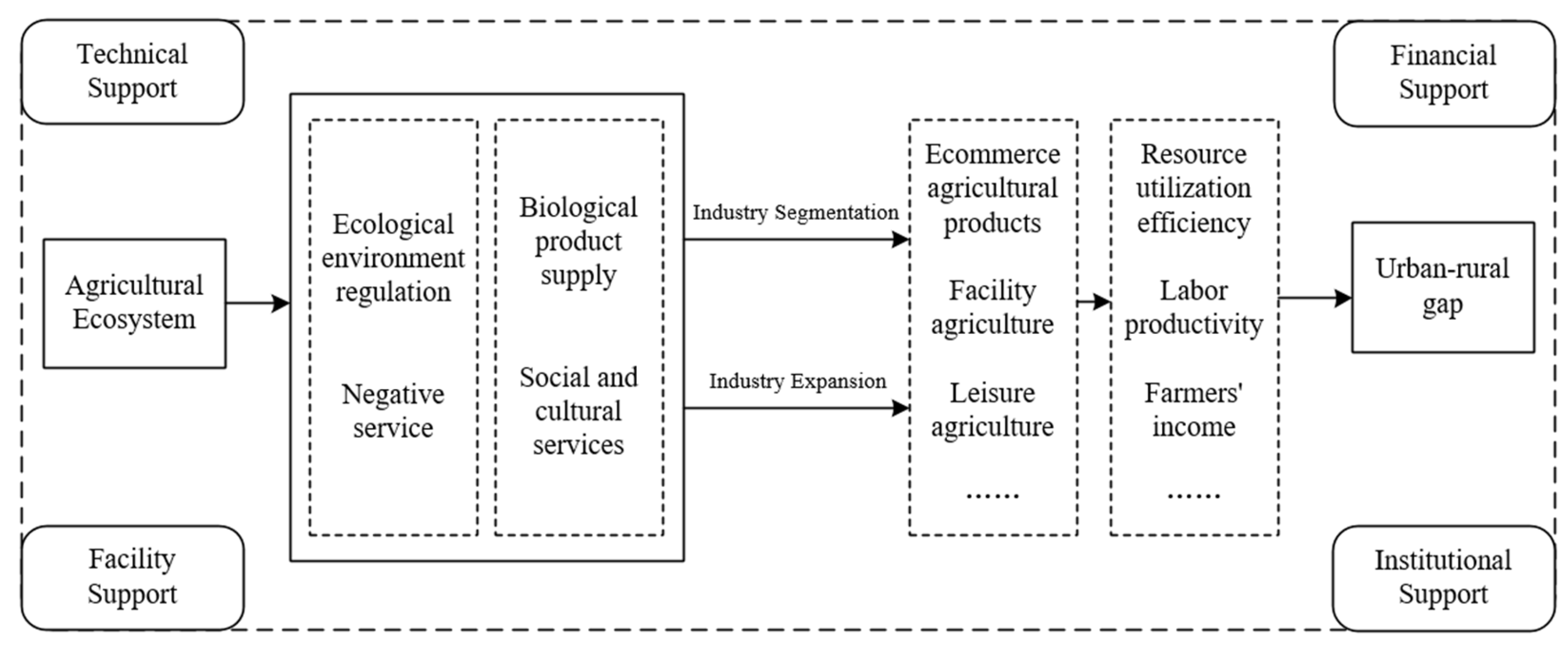
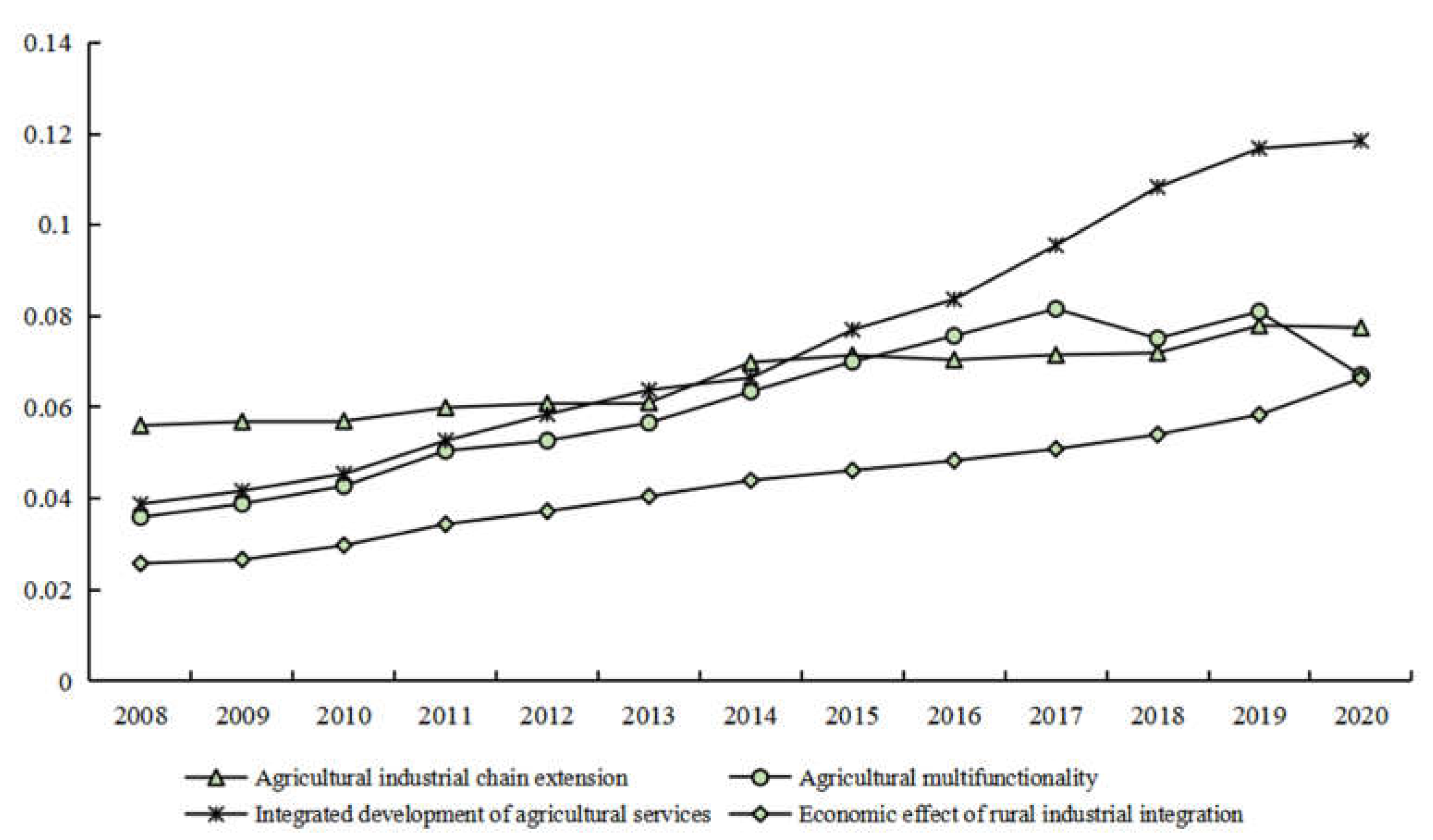

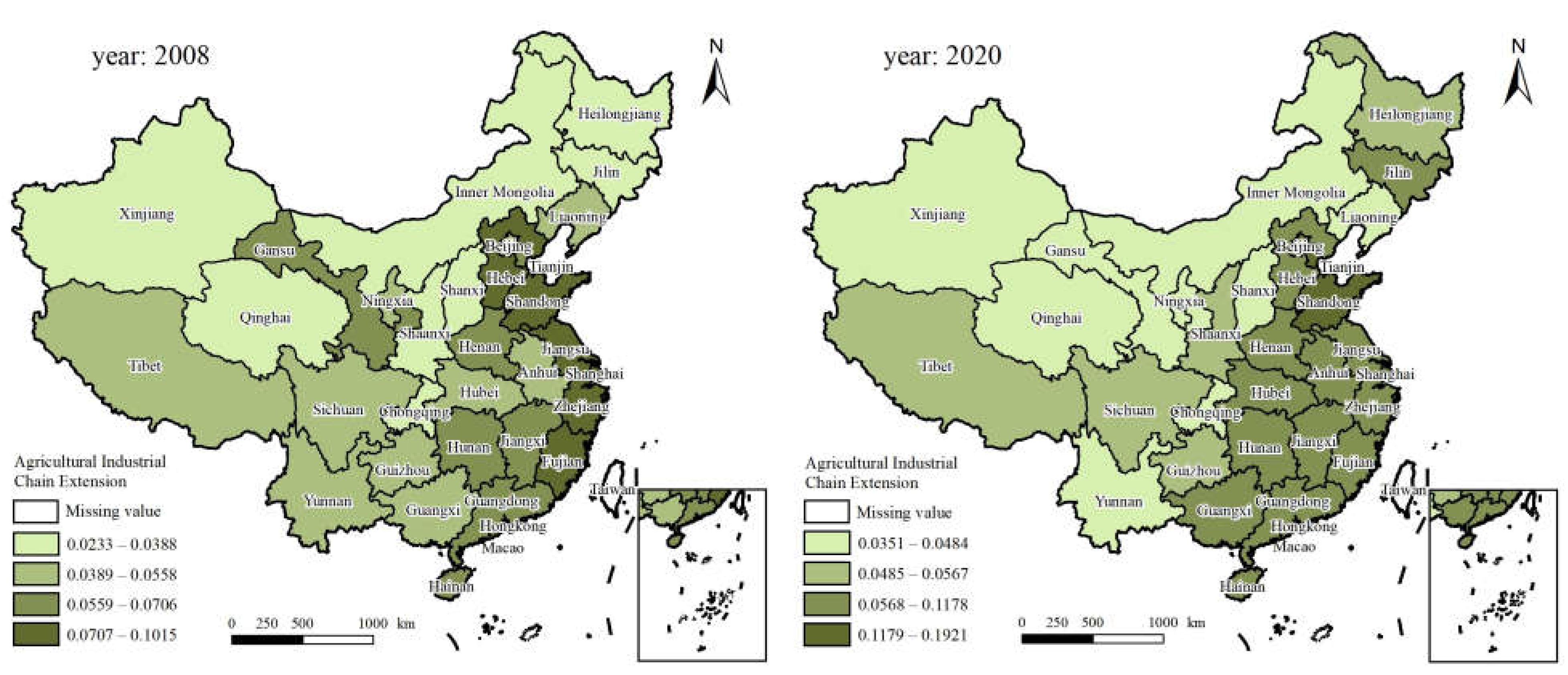

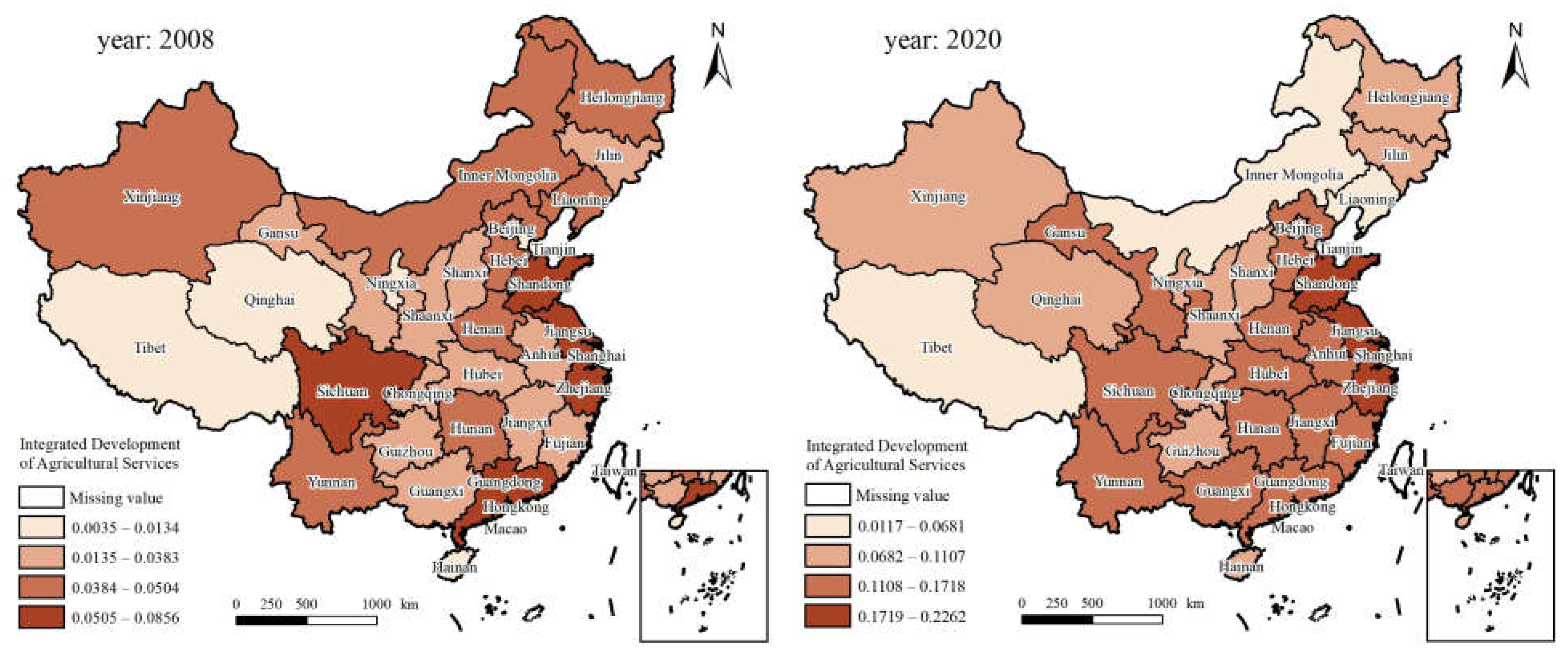
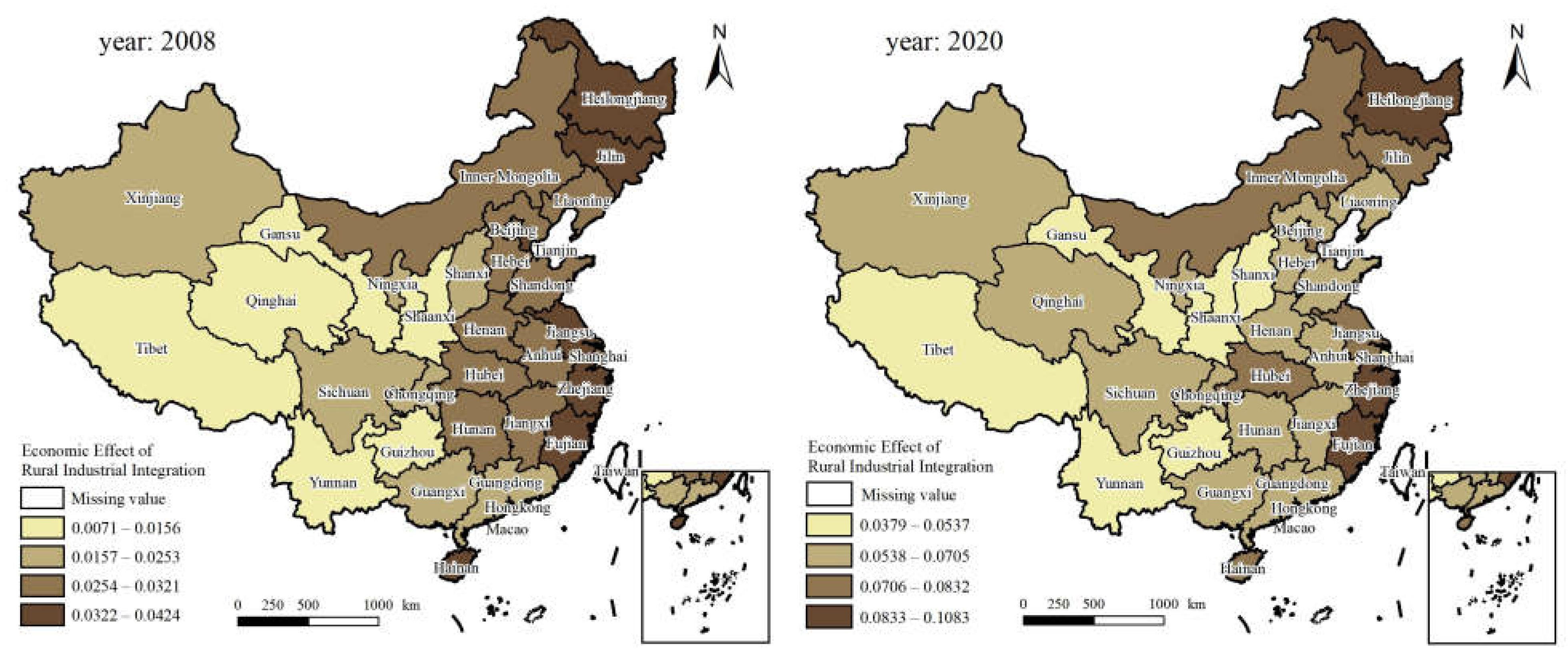
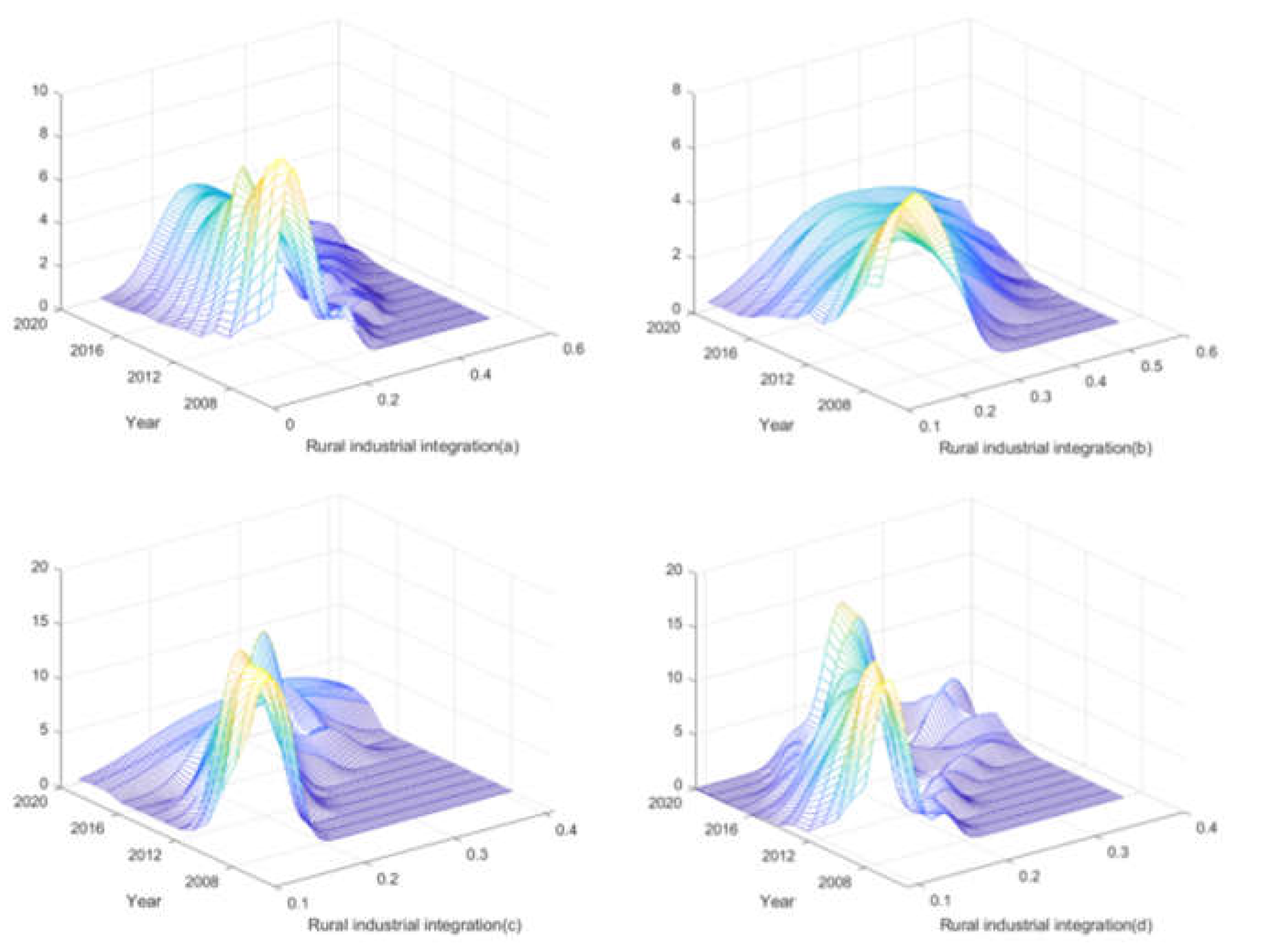
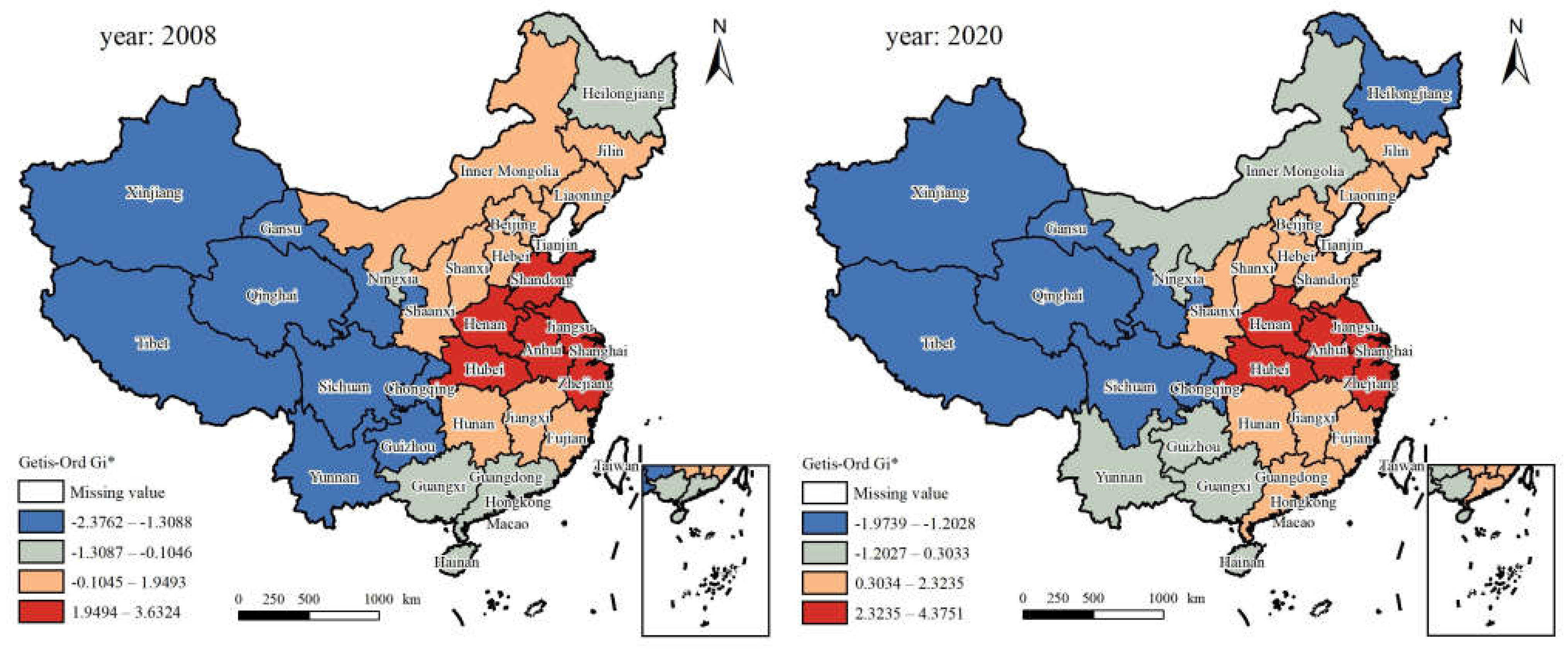
| Component | Indicators | Calculation | Weight |
|---|---|---|---|
| Agricultural industrial chain extension | Commodity rate of agricultural products (+) | Operating income of agricultural product processing industry/total agricultural output value | 0.1482 |
| Degree of agricultural mechanization (+) | Total power of agricultural mechanization/cultivated land area | 0.0514 | |
| Proportion of primary industry output value to GDP (+) | Output value of primary industry/GDP | 0.0419 | |
| Industrial structure optimization (+) | Total output value of agriculture, forestry, animal husbandry and fishery services/total output value of agriculture | 0.0453 | |
| Agricultural multifunctionality | Facility agriculture scale (+) | Area of facility agriculture/cultivated land | 0.1657 |
| Proportion of leisure agriculture output value (+) | Operating income of leisure agriculture/total agricultural output value | 0.1326 | |
| Fertilizer application intensity (−) | Fertilizer application amount/cultivated land area | 0.0143 | |
| Application intensity of pesticides (−) | Pesticide application amount/cultivated land area | 0.0113 | |
| Integrated development of agricultural services | Agricultural loan (+) | Balance of agricultural loans in local and foreign currencies of financial institutions | 0.1014 |
| Investment in agricultural science and technology research and experiment | Number of technicians invested in agricultural scientific research and experiment | 0.0549 | |
| Growth rate of rural fixed asset investment (+) | Growth rate of rural fixed asset investment | 0.0132 | |
| Rural Internet penetration rate (+) | Number of rural Internet broadband access households/total number of rural households | 0.1041 | |
| Economic effect of rural industrial integration | Income ratio of urban and rural residents (−) | Urban residents’ disposable income/rural residents’ disposable income | 0.0162 |
| Consumption ratio of urban and rural residents (−) | Consumption expenditure of urban residents/consumption expenditure of rural residents | 0.0131 | |
| Net operating income of rural residents (+) | Per capita net operating income of rural residents | 0.0312 | |
| Agricultural labor productivity (+) | Operating income of agricultural product processing industry/total agricultural output value | 0.0552 |
| Component | Indicator | Mean | Maximum | Minimum | Std. Dev. |
|---|---|---|---|---|---|
| Agricultural industrial chain extension | Commodity rate of agricultural products | 3.4543 | 25.0055 | 0.0345 | 4.3479 |
| Degree of agricultural mechanization (kw/hm2) | 8.0969 | 18.1555 | 2.1438 | 3.7593 | |
| Proportion of primary industry output value to GDP | 10.2864 | 30.0000 | 0.3000 | 5.2470 | |
| Industrial structure optimization | 0.0772 | 0.2089 | 0.0220 | 0.0333 | |
| Agricultural multifunctionality | Facility agriculture scale | 0.0173 | 0.1432 | 0.0000 | 0.0227 |
| Proportion of leisure agriculture output value | 0.0756 | 0.4375 | 0.0010 | 0.0873 | |
| Fertilizer application intensity (t/hm2) | 0.4711 | 1.1872 | 0.0830 | 0.2283 | |
| Application intensity of pesticides (t/hm2) | 0.0155 | 0.0645 | 0.0016 | 0.0133 | |
| Integrated development of agricultural services | Agricultural loan(billion yuan) | 7140.7130 | 40,234.0000 | 54.7108 | 7171.1380 |
| Investment in agricultural science and technology research and experiment | 21,931.9800 | 56,991.0000 | 1703.6060 | 12,669.9500 | |
| Growth rate of rural fixed asset investmentt | 0.0568 | 1.7518 | −0.5313 | 0.1965 | |
| Rural Internet penetration rate | 0.3196 | 1.0000 | 0.0000 | 0.2901 | |
| Economic effect of rural industrial integration | Income ratio of urban and rural residents | 2.6965 | 4.0041 | 1.8451 | 0.4424 |
| Consumption ratio of urban and rural residents | 2.3191 | 3.6964 | 1.5098 | 0.4099 | |
| Net operating income of rural residents (yuan) | 4062.6280 | 9141.1000 | 589.7400 | 1689.4750 | |
| Agricultural labor productivity (yuan) | 25,359.5100 | 10,6798.1000 | 4005.7170 | 14,672.8100 |
| Component | Indicator | Data Sources |
|---|---|---|
| Agricultural industrial chain extension | Commodity rate of agricultural products | “Yearbook of China’s agricultural product processing industry“ “China Rural Statistical Yearbook“ |
| Degree of agricultural mechanization | Database of the National Bureau of Statistics of the People’s Republic of China “China Rural Statistical Yearbook“ | |
| Proportion of primary industry output value to GDP | Database of the National Bureau of Statistics of the People’s Republic of China “China Rural Statistical Yearbook“ | |
| Industrial structure optimization | Database of the National Bureau of Statistics of the People’s Republic of China “China Rural Statistical Yearbook“ | |
| Agricultural multifunctionality | Facility agriculture scale | Database of National greenhouse “China Rural Statistical Yearbook“ |
| Proportion of leisure agriculture output value | “China Leisure Agriculture Yearbook“ “China Rural Statistical Yearbook“ | |
| Fertilizer application intensity | Database of the National Bureau of Statistics of the People’s Republic of China “China Rural Statistical Yearbook“ | |
| Application intensity of pesticides | Database of the National Bureau of Statistics of the People’s Republic of China “China Rural Statistical Yearbook“ | |
| Integrated development of agricultural services | Agricultural loan | “China Financial Yearbook“ “China Rural Statistical Yearbook“ |
| Investment in agricultural science and technology research and experiment | Database of the National Bureau of Statistics of the People’s Republic of China | |
| Growth rate of rural fixed asset investment | Database of the National Bureau of Statistics of the People’s Republic of China “China Rural Statistical Yearbook“ | |
| Rural Internet penetration rate | Database of the National Bureau of Statistics of the People’s Republic of China “China Rural Statistical Yearbook“ | |
| Economic effect of rural industrial integration | Income ratio of urban and rural residents | Database of the National Bureau of Statistics of the People’s Republic of China “China Rural Statistical Yearbook“ |
| Consumption ratio of urban and rural residents | Database of the National Bureau of Statistics of the People’s Republic of China “China Rural Statistical Yearbook“ | |
| Net operating income of rural residents | Database of the National Bureau of Statistics of the People’s Republic of China “China Rural Statistical Yearbook“ | |
| Agricultural labor productivity | Database of the National Bureau of Statistics of the People’s Republic of China “China Rural Statistical Yearbook“ |
| Variable | Description | |
|---|---|---|
| Dependent variable | rural industry integration developent index | Evaluation model calculation results |
| Independent variable | urbanization level | Proportion of urban population and rural population (%) |
| rural human capital | Rural residents’ per capita years of education | |
| rural transportaion facilities | Ratio of highway mileage to provincial area (km/100 (km)2) | |
| rural ecological environment | The ratio of water and soil loss control area to regional area, expressed by growth rate (%) | |
| the intensity of fiscal support for agriculture | Ratio of fiscal expenditure on agriculture affairs to total output value of agriculture, forestry, animal husbandry and fishery (%) | |
| the degree of industrial upgrading | Ratio of gross output value of secondary and tertiary industries to gross regional product (%) | |
| rural digitalization | Degree of digitalization in rural areas, expressed by growth rate (%) |
| Variable | LLC | IPS | ADF-Fisher | PP-Fisher | ||||
|---|---|---|---|---|---|---|---|---|
| Statistic | Prob. | Statistic | Prob. | Statistic | Prob. | Statistic | Prob. | |
| lnRID | −11.5356 | 0.0000 *** | −3.1516 | 0.0008 *** | 107.6290 | 0.0002 *** | 176.9920 | 0.0000 *** |
| lnURB | −7.4205 | 0.0000 *** | 0.5576 | 0.7114 | 69.3490 | 0.1914 | 117.1760 | 0.0000 *** |
| lnCAP | −7.7667 | 0.0000 *** | −2.9063 | 0.0018 *** | 93.1197 | 0.0040 *** | 130.4700 | 0.0000 *** |
| lnTRA | −10.0843 | 0.0000 *** | −5.5636 | 0.0000 *** | 147.2840 | 0.0000 *** | 191.7280 | 0.0000 *** |
| lnENV | −13.4860 | 0.0000 *** | −8.4638 | 0.0000 *** | 174.9150 | 0.0000 *** | 184.6660 | 0.0000 *** |
| lnFIN | −20.8045 | 0.0000 *** | −16.7741 | 0.0000 *** | 266.4400 | 0.0000 *** | 385.7310 | 0.0000 *** |
| lnIND | −11.1858 | 0.0000 *** | −4.6597 | 0.0000 *** | 128.9470 | 0.0000 *** | 157.3080 | 0.0000 *** |
| lnINT | −14.5345 | 0.0000 *** | −10.0559 | 0.0000 *** | 201.5350 | 0.0000 *** | 220.7370 | 0.0000 *** |
| Variable | All | Eastern | Central | Western | ||||
|---|---|---|---|---|---|---|---|---|
| Coefficent | Prob. | Coefficent | Prob. | Coefficent | Prob. | Coefficent | Prob. | |
| C | 1.4643 | 0.001 *** | 1.4804 | 0.013 ** | 2.3926 | 0.001 *** | 2.1619 | 0.025 ** |
| lnURB | 0.8265 | 0.002 *** | 1.1695 | 0.037 ** | 1.5041 | 0.011 ** | 0.6090 | 0.076 * |
| lnCAP | 0.3026 | 0.228 | 1.6393 | 0.013 ** | 0.2351 | 0.650 | 0.1043 | 0.505 |
| lnTRA | 0.4055 | 0.043 ** | 1.8115 | 0.054 * | 1.5317 | 0.011 ** | 0.4317 | 0.076 * |
| lnENV | 0.1351 | 0.012 ** | -0.0385 | 0.595 | 0.0748 | 0.168 | 0.1130 | 0.219 |
| lnFIN | 0.2788 | 0.002 *** | 0.0268 | 0.485 | 0.1762 | 0.273 | 0.7760 | 0.008 *** |
| lnIND | 0.0827 | 0.627 | -0.2736 | 0.079 * | -0.4473 | 0.046 ** | -0.4437 | 0.620 |
| lnINT | 0.1792 | 0.004 *** | 0.0849 | 0.111 | 0.1181 | 0.032 ** | 0.3189 | 0.228 |
| Sample size | 403 | 156 | 117 | 130 | ||||
| Model | FE | FE | FE | FE | ||||
Disclaimer/Publisher’s Note: The statements, opinions and data contained in all publications are solely those of the individual author(s) and contributor(s) and not of MDPI and/or the editor(s). MDPI and/or the editor(s) disclaim responsibility for any injury to people or property resulting from any ideas, methods, instructions or products referred to in the content. |
© 2023 by the authors. Licensee MDPI, Basel, Switzerland. This article is an open access article distributed under the terms and conditions of the Creative Commons Attribution (CC BY) license (https://creativecommons.org/licenses/by/4.0/).
Share and Cite
Wang, R.; Shi, J.; Hao, D.; Liu, W. Spatial–Temporal Characteristics and Driving Mechanisms of Rural Industrial Integration in China. Agriculture 2023, 13, 747. https://doi.org/10.3390/agriculture13040747
Wang R, Shi J, Hao D, Liu W. Spatial–Temporal Characteristics and Driving Mechanisms of Rural Industrial Integration in China. Agriculture. 2023; 13(4):747. https://doi.org/10.3390/agriculture13040747
Chicago/Turabian StyleWang, Rui, Jianwen Shi, Dequan Hao, and Wenxin Liu. 2023. "Spatial–Temporal Characteristics and Driving Mechanisms of Rural Industrial Integration in China" Agriculture 13, no. 4: 747. https://doi.org/10.3390/agriculture13040747
APA StyleWang, R., Shi, J., Hao, D., & Liu, W. (2023). Spatial–Temporal Characteristics and Driving Mechanisms of Rural Industrial Integration in China. Agriculture, 13(4), 747. https://doi.org/10.3390/agriculture13040747






